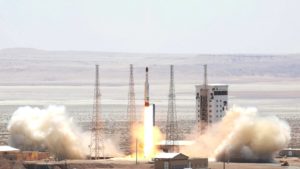
A report authored by two prominent missile experts and published on 2 March, 2018, by the prominent think-tank, the International Institute for Strategic Studies (IISS), have asserted that Iran’s satellite launch vehicle capabilities are most likely not a ruse for an intercontinental ballistic missile programme, as claimed by a number of countries opposed to Iran’s nuclear weapons and regional ambitions.
The report, titled “Assessing whether Iran’s ballistic missiles are designed to be nuclear-capable,” by Michael Elleman and Mark Fitzpatrick, asserts that contrary to claims by many analysts and intelligence agencies, Iran’s space launch vehicles (SLV’s) – the Safir and the Simorgh – are highly unlikely to be cover programmes for a long-range intercontinental ballistic missile (ICBM) programme
“Iran’s two space-launch rockets, the Safir and Simorgh, are optimized for launching satellites, and are not well suited to perform as a ballistic missile, for which they have never been tested. The second-stage propulsion systems for both rockets rely on low-thrust, long-action time engines, which are ideal for accelerating a satellite on a path parallel to the earth’s surface and into a sustainable orbit. But such engines are poorly suited for ballistic missile trajectories, which reach higher altitudes. Plus, the large and cumbersome Simorgh, which is prepared for launch over an extended time on a fixed launching pad, would be vulnerable to pre-launch attack,” Elleman and Fitzpatrick write in a summary of their IISS report published on the strategy website War on the Rocks.
According to Elleman and Fitzpatrick, these engineering and technical features in the Safir and Simorgh launch vehicles – as well as in practically all other launch vehicles historically developed – makes it both unlikely and impractical for Iran to use them as a surreptitious means to develop an ICBM
“This is one reason no country has converted a satellite launcher into a long-range ballistic missile. SLV programs may assist ICBM development, but historically they have never proven to be decisive in their contribution. There are other reasons satellite launchers are not used for warhead delivery, including very different operational criteria and the requirement that a missile’s payload must survive the stresses experienced during atmospheric re-entry.”
While Elleman and Fitzpatrick are skeptical of popular claims that Iran’s SLV’s are a cover for an illicit ICBM programme, however, they do sound the alarm about Iranian short- and medium-range ballistic missiles (SRBM and MRBM, respectively), saying that a greater focus and effort by the international community is required to ban Iranian MRBM’s in particular:
“Rolling back Iran’s most dangerous missiles will require concerted attention. The United States and its European allies should correctly define the problem and focus on seeking restrictions on the missiles that could be most easily used to deliver nuclear weapons (if Iran were to completely abandon the JCPOA and the Nuclear Non-Proliferation Treaty). In prioritizing the most dangerous systems, they should discuss how to ban Iranian testing of missiles that, according to documents provided to the International Atomic Energy Agency, originally were designed to accommodate an apparent nuclear payload, like the 1000-mile range Ghadr. Having such a missile capability would serve well Iran’s nuclear hedging strategy. These systems should be targeted for an extended ban by the UN and for related sanctions on individuals and entities associated with the system.”
Iranian SRBM’s, however, should not be explicitly banned but punitive measures against Tehran should be put in place should such weapons be exported to Iranian proxies and allies across the Middle East.
“Meanwhile, shorter-range Iranian missiles systems that are not nuclear-capable should not be allowed to be transferred to Hezbollah and other outside groups, but need not be banned in Iran’s hands. The Fateh-110 family of missiles, for example, clearly are not intended for nuclear use.”
Elleman and Fitzpatrick also acknowledge the central role ballistic missiles play in Iran’s national security strategy and recent strategic culture, especially given the resource and diplomatic constraints placed upon Tehran that prevent it from funding, building, and acquiring a modern and effective air force.
“Let’s be realistic: Iran will not surrender its ballistic missile program. Rockets play too central a role in Iran’s defense and deterrence posture, especially given its antiquated and inferior air force. The need for missiles is also deeply embedded in the national psyche, from the days in the mid-1980s when acquiring and firing back Scud missiles was the only way to retaliate against Iraqi missile strikes on Iranian cities.”
“A realistic solution involves differentiating among Iranian missile systems. Not all of them are inexplicably linked to nuclear weapons development. Those that obviously are should be curtailed. It may be necessary to allow limited and transparent space launch development. Meanwhile, Iran’s neighbors will have to live with its shorter-range systems, for which integrated missile defenses present the best counter-measure. It’s not a perfect solution, but it’s a realistic way to deal with the real issue,” Elleman and Fitzpatrick argue.
Reaction to the Elleman and Fitzpatrick report have yet to filter through to policy circles in the Middle East, Europe, and the United States at the time of reporting.
 SpaceWatch.Global An independent perspective on space
SpaceWatch.Global An independent perspective on space

